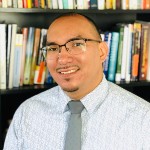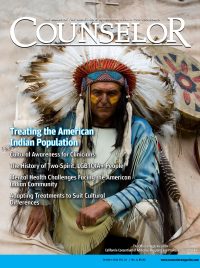Share
The field of mental health is very much focused on what science has to say regarding healing. There are many “one-size-fits-all” approaches to treatment. We see this in different curricula that are utilized to treat a group of individuals regardless of their ethnicity and cultural background. The concept of cultural competence is difficult to gauge—how does one know when they are competent, and is this a process or an outcome? As a mental health professional and a member of the Sisseton Wahpeton Oyate, I am writing this article in order to provide insights into working with the American Indian community. It is based on my personal experiences as an urban native, a professionally trained and certified substance use disorder (SUD) counselor who has worked primarily with this population for over a decade, and my other half’s (i.e., Victoria Blacksmith’s) doctoral research focused on decolonizing the field of mental health.
There are many important factors that providers should take into account when working with the American Indian population, beginning with the founding of the United States, which negatively impacted this population in many ways. It is essential to acknowledge that awful things took place with the rational and foundational thought of civilizing, educating, and bringing order to the newly founded America. What this meant for American Indian people was the attempted destruction of all things traditional, such as language, healing, medicines, and more. This was followed by the opening and forced use of boarding schools for American Indian children. These children were removed from their homes in an attempt at assimilation, and many of them did not return home (Running Bear, Croy, Kaufman, Thayer, & Manson, 2018). Those who did and lived to be adults experienced poorer physical health statuses when compared to individuals who did not have boarding school experiences (Running Bear et al., 2018). The use of traditional healing methods was outlawed and had to be taken underground for protection, forcing our ancestors to risk life and liberty to protect our traditional practices. The empty promises of a better life, the terms, “happy home and job training” were advertised to lure many American Indian individuals and families off the reservation and into metropolitan areas with the passing of the American Indian Termination and Removal Act (SAMHSA, 2018).
A Personal Story
My family was impacted by all the aforementioned situations, some attending boarding schools, others living through the criminalization of traditional healing practices, and many having relocated to the Bay Area. The American Indian Relocation Act of 1952 was designed to offer American Indian people living on reservations an opportunity to relocate to an urban/metropolitan area (SAMHSA, 2018). Participants in this program could go from the reservation to cities like Chicago, Denver, Cleveland, and California. As a result, during the 1950s and 1960s cities in both Northern and Southern California experienced an influx of American Indian people relocating to the region. However, this left countless American Indian people in a new place without resources, support, and the promised jobs and training programs.
It was my grandparents, Elmer and Martha St. John, who made the decision to move our family from Sisseton, South Dakota to Oakland, California in search of greater opportunities and a better life. This relocation proved to be more difficult than expected, as poverty, substance use, homelessness, and a lack of overall support was what they found when they arrived. These large relocation programs with no support resulted in increased rates of substance use and homelessness (SAMHSA, 2018). The continued lack of support and response from city and county officials led to American Indian communities identifying their own resources and support, creating urban centers that aided in preserving cultural identity. This occurred during the 1970s and 1980s, when we began to see the start of culturally appropriate services taking root in intertribal communities. The use of traditional ceremonial practices as part of the recovery process from drugs and alcohol became commonplace. Traditional practitioners and other community elders were instrumental in advocating, developing, and implementing a community-driven system of care for American Indian people.
I have great memories of my community during these times; the times of pow-wows, drum practices, and community dinners. My primary caregivers, like many other American Indian children, were my aunts and grandmothers. My mother and father were unable to care for me and I was placed in the care of my grandmother and aunts. At that time, the Indian Child Welfare Act of 1978 (NILL, n.d.) was put into place to protect native children like me. The Act provides specific direction on the removal of native children, and it also transfers jurisdiction of child removal cases from state courts to tribal courts (NILL, n.d.). In addition, the Act protects children from being placed in non-American-Indian homes and allows greater support to extended family members who are able to care for these children. I was fortunate to have family who took care of me and allowed me to continue to be part of the American Indian community.
Growing up as an urban native was confusing at times. I attended church periodically with my aunt, a devout Christian through boarding school introduction. I was also exposed to traditional tools like prayer ties and sage, and I would see prayer flags hanging with little understanding of their meaning and purpose. At the time I was unaware of how powerful and necessary these items were to my health and well-being. As I stumbled through adolescence, like many of us do, I wondered about these tools. Research indicates a connection between cultural identity in adolescent American Indians and alcohol and drug use, indicating that those with stronger cultural identity and involvement in cultural activities are at increased potential for positive and healthy constructs and are less likely to engage in alcohol and drug use (Brown, Dickerson, & D’Amico, 2016). It was not until a few years into early adulthood and after my reintroduction to these tools that I truly understood the importance of culture and traditional practices.
The Data
Part of cultural awareness is having knowledge of the disparities faced by the people we serve. It is essential to understand the demographic representation and relevant risk factors (e.g., trauma, substance use, suicidality, etc.) that affect different racial/ethnic communities. Here are just some of the statistics about the American Indian population:
- American Indians are nationally 6.6 times more likely to have an alcohol-induced death than the general population (IHS, 2019).
- American Indians experience higher rates of psychological distress due to suffering first-hand trauma and/or being exposed to traumatic events at rates higher than that of the US population as a whole (Goodkind, Gorman, Hess, Parker, & Hough, 2015).
- American Indians born today have a life expectancy that is 5.5 years less than that of all races in the US population (IHS, 2019).
- American Indian rates of suicide are disproportionately higher than in other races (Leavitt et al., 2018; IHS, 2019).
The National Violent Death Reporting System (NVDRS) captures suicide rates in eighteen different states. The NVDRS observed an increase in suicide rates in the American Indian/Alaska Native (AI/AN) population beginning in 2003, with rates at times increasing to 3.5 times higher than other racial groups (Leavitt et al., 2018). Additionally, American Indians are more likely to report substance and alcohol use than any other race (IHS, 2019).
Trauma
Why should providers approach trauma work with American Indian people differently than other populations? Have all people not experienced some sort of trauma? The answer to that question is more complex than we may think. Yes, many people have experienced significant trauma that impacts their ability to function and/or creates psychological distress. What is different about the American Indian population is the intergenerational and historical trauma they have experienced. Each individual, family, tribe, and clan has unique experiences that apply to a lot of the work that is done outside of the native community. This type of trauma is considered by clinicians and researchers as the cumulative emotional and psychological wounding that spans several generations and that emanates from massive group trauma (SAMHSA, 2018). Several nonexhaustive examples of this trauma were provided earlier in this article.
There are, however, countless more examples of the long history of government policies that were enacted against American Indian people that are responsible for the issues we see in our communities today and that contributes to the distrust of care providers. The collateral effect of colonization has led to the development of an ongoing influence of racial discrimination, stereotypes, and retraumatization of American Indian people. The racial discrimination and microaggressions that our people continue to experience not only discourage these community members from seeking treatment, but also contribute to higher rates of psychological stressors, anger, and personal distress (Skewes & Blume, 2019). Many providers are unaware of the Indian Relocation Act and other factors that contribute to American Indian people seeking services outside of tribal land, leaving many to dismiss the importance of learning more about this population. Based on the 2020 Census, and unbeknownst to most providers, 78 percent of the American Indian population is urban, meaning they reside off tribal lands and are being served in your clinics and organizations (OMH, 2021). American Indian people have adapted well to the urban environment over time, but many of our people struggled with institutional, economic, geographical, and cultural barriers to accessing and receiving care (Clark, 2006).
Cultural Considerations for Providers
It is important to highlight the barriers and disparities in the current system regarding American Indian access to SUD programs that are culturally responsive to their needs and/or from organizations that ensure American-Indian-specific training is provided to their staff. These are important and relevant factors, as American Indian people are likely to receive services from one of the many community-based programs that may lack cultural inclusivity.
There is a significant amount of information available to providers that discusses the importance of cultural considerations for this specific population. Many of this information will give you specific curricula that should be utilized when working with American Indians; other sources will tell you it is important that native clients have access to traditional healers and traditional healing methods; and still other information highlights the importance of allowing clients to participate in ceremonies during treatment. All the aforementioned considerations are valid, however, and agencies and/or individuals should be very cautious with how to proceed on acquiring the training and services relevant to their native clients. It will not do to simply Google “traditional Native American healer,” as this in itself has very specific considerations that may not even be accessible to individuals outside of the American Indian community.
Many of these considerations require collaboration and training directly from the American Indian community. It is important to understand and acknowledge the ancestral and historical aspects of American Indian clients. It is also important that providers be cautious and not project the understanding they have regarding American Indian clients. When working with many other ethnicities, it is important that we do not group all American Indian clients into one box and assume that all American Indian individuals utilize traditional healing practices, speak their native language, or have an in-depth understanding of where they come from. Doing so may be detrimental to clients, as it could cause identity confusion and may be the underlying cause of the distress they are experiencing (Duran, 2006). It may be helpful to frame these traumatic experiences and issues as the collective experience of American Indian people, one that may also include a community approach to “healing” (i.e., recovering) and “wellness” (i.e., maintenance) from substance use issues. These are two terms that many American Indian communities have adopted in contrast to western treatment and recovery terms. Utilizing more holistic language and refraining from diagnostic terms or terms like “alcoholic” and “addict” are beneficial when working with all individuals, but specifically with the American Indian community. It is important that we decolonize the ideology of referring to individuals in this way (Duran, 2006).
Conclusion
As providers we may deem individuals like myself as those who are not amenable to treatment and who are unwilling to participate in their treatment plan, failing to identify the cultural considerations and culturally specific interventions that should be used with the American Indian population. Working with American Indian treatment providers as well as individuals who received specific training from the American Indian community on appropriate treatment approaches, cultural considerations, and the use of traditional practices as part of treatment was what saved my life. It is important to acknowledge the body of research that supports the use of traditional healing practices with the American Indian population (Marsh, Coholic, Cote-Meek, & Najavits, 2015). Understanding that this population has the ability to have more favorable and positive outcomes if and when their culture is integrated into their treatment is where we begin. Understanding this piece is where providers and organizations should begin in their quest to obtain additional training on working with this population.
As a provider I have spent a decade of my life devoted to treating my own people, utilizing traditional approaches to healing integrated with western methodologies of treatment. I was able to observe the most beautiful transformations in individuals, families, and our intertribal community. I also take time to provide training and support to those organizations who are lacking in their understanding of working with this population, helping individuals understand and apply cultural considerations, teaching the handling of tools, medicine, and other culturally specific needs. I write this article with the hope that service providers, administrators, and directors pursue American-Indian-specific trainings for their staff and organizations, especially if they currently treat or plan to provide services to the American Indian population.
References
- Barrett, C. A. (2019). Indian child welfare act. In Salem Press Encyclopedia. Salem Press.
- Brown, R. A., Dickerson, D. L., & D’Amico, E. J. (2016). Cultural identity among urban American Indian/Alaska Native youth: Implications for alcohol and drug use. Prevention Science, 17(7), 852–61.
- Clark, R. L. (2006). Healing the generations: Urban American Indians in recovery. In T. M. Witko (Ed.), Mental health care for urban Indians: Clinical insights from Native practitioners (pp. 83–99). Washington, DC: American Psychological Association.
- Duran, E. (2006). Healing the soul wound: Counseling with American Indians and other native peoples. New York, NY: Teachers College Press.
- Goodkind, J. R., Gorman, B., Hess, J. M., Parker, D. P., & Hough, R. L. (2015). Reconsidering culturally competent approaches to American Indian healing and well-being. Qualitative Health Research, 25(4), 486–99.
- Indian Health Service (IHS). (2019). Disparities. Retrieved from https://www.ihs.gov/newsroom/factsheets/disparities/
- Leavitt, R. A., Ertl, A., Sheats, K., Petrosky, E., Ivey-Stephenson, A., & Fowler, K. A. (2018). Suicides among American Indian/Alaska Natives – National violent death reporting system, eighteen states, 2003–2014. Morbidity and Mortality Weekly Report, 67(8), 237–42.
- Marsh, T. N., Coholic, D., Cote-Meek, S., & Najavits, L. M. (2015). Blending Aboriginal and Western healing methods to treat intergenerational trauma with substance use disorder in Aboriginal peoples who live in Northeastern Ontario, Canada. Harm Reduction Journal, 12.
- National Indian Law Library (NILL). (n.d.). A practical guide to the Indian Child Welfare Act. Retrieved from https://narf.org/nill/documents/icwa/index.html
- US Office of Minority Health (OMH). (2021). Profile: American Indian/Alaska Native. Retrieved from https://minorityhealth.hhs.gov/omh/browse.aspx?lvl=3&lvlid=62
- Running Bear, U., Croy, C. D., Kaufman, C. E., Thayer, Z. M., & Manson, S. M. (2018). The relationship of five boarding school experiences and physical health status among Northern Plains Tribes. Quality of Life Research, 27(1), 153–7.
- Skewes, M. C., & Blume, A. W. (2019). Understanding the link between racial trauma and substance use among American Indians. American Psychologist, 74(1), 88–100.
- Substance Abuse and Mental Health Services Administration (SAMHSA). (2018). Behavioral health services for American Indians and Alaska Natives: For behavioral health service providers, administrators, and supervisors. Treatment improvement protocol (TIP) 61. Retrieved from https://store.samhsa.gov/sites/default/files/d7/priv/tip_61_aian_full_doc
About Me
Nathan Blacksmith, CADC-III, CTE, SAP, is an enrolled member of the Sisseton Wahpeton Oyate of Lake Traverse, South Dakota (Dakota Tribe). He is a second-generation urban American Indian, as his grandparents participated in the Relocation Act of 1956 from their reservation to Oakland, California. Blacksmith currently services on the board of directors for the Native American Health Center and has expertise in SUD counseling and specific training in traditional American Indian practices and the use of traditional medicines in the treatment setting. He currently holds a certification from CCAPP and is currently pursuing his master’s in business administration.
Victoria Blacksmith, MA, is first generation born in the United States, her people being from south of the border in Guadalajara, Mexico. She is the first in her family to earn a master’s degree, she holds a bachelor’s degree in psychology, and she is currently pursuing her PhD in clinical psychology. Blacksmith is an organizational consultant who provides support primarily to minority-owned, nonprofit organizations. During her career, she has served as the executive director for the Friendship House Association of American Indians and as a supervising detention officer for the Yolo County Department of Probation, working with incarcerated youth and youth involved in immigration proceedings. Blacksmith currently serves as the clinical director for Granite Recovery Centers and provides individual psychotherapy in private practice.











 Counselor Magazine is the official publication of the California Association of Addiction Programs and Professionals (CCAPP). Counselor offers online continuing education, article archives, subscription deals, and article submission guidelines. It has been serving the addiction field for more than thirty years.
Counselor Magazine is the official publication of the California Association of Addiction Programs and Professionals (CCAPP). Counselor offers online continuing education, article archives, subscription deals, and article submission guidelines. It has been serving the addiction field for more than thirty years.